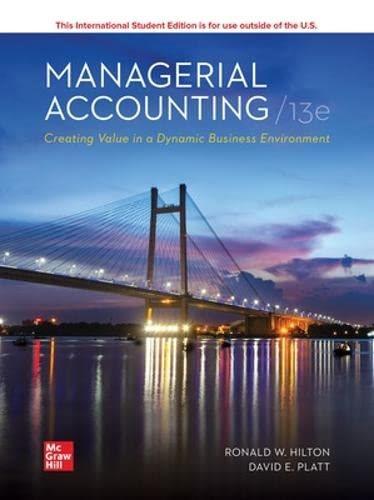Question
Answer True or False to Questions #1 through #35: 1.Conversion cost is the sum of direct labor cost and manufacturing overhead cost. 2.Prime cost equals
Answer True or False to Questions #1 through #35:
1.Conversion cost is the sum of direct labor cost and manufacturing overhead cost.
2.Prime cost equals manufacturing overhead cost.
3.A decrease in production will ordinarily result in a decrease in fixed production costs per unit.
4.A fixed cost fluctuates in total as activity changes but remains constant on a per unit basis over the relevant range.
5.Opportunity costs at a manufacturing company are not part of manufacturing overhead.
6.If the activity level increases, then one would expect the fixed cost per unit to increase as well.
7.Within the relevant range, a change in activity results in a change in variable cost per unit and total fixed cost.
8.The following costs are all examples of committed fixed costs: depreciation on buildings, salaries of highly trained engineers, real estate taxes, and insurance expenses.
9.Contribution margin and gross margin mean the same thing.
10.A continuous or perpetual budget is a 12-month budget that rolls forward one month (or quarter) as the current month (or quarter) is completed.
11.The basic idea underlying responsibility accounting is that a manager should be held responsible for those itemsand only those itemsthat the manager can actually control to a significant extent.
12.The formula for computing the predetermined overhead rate is:
13.Predetermined overhead rate = Estimated total manufacturing overhead cost Estimated total amount of the allocation base
14.If the overhead rate is computed annually based on the actual costs and activity for the year, the manufacturing overhead assigned to any particular job can be computed as soon as the job is completed.
15.The fact that one department may be labor intensive while another department is machine intensive explains in part why multiple predetermined overhead rates are often used in larger companies.
16.In absorption costing, nonmanufacturing costs are assigned to units of product.
17.If the allocation base in the predetermined overhead rate does not drive overhead costs, it will nevertheless provide reasonably accurate unit product costs because of the averaging process.
18.To estimate what the profit will be at various levels of activity, multiply the number of units to be sold above or below the break-even point by the unit contribution margin.
19.In two companies making the same product and with the same total sales and total expenses, the contribution margin ratio will be lower in the company with a higher proportion of fixed expenses in its cost structure.
20.If the variable expense per unit decreases, and all other factors remain the same, the contribution margin ratio will increase.
21.The break-even point in units can be obtained by dividing total fixed expenses by the unit contribution margin
22.Under variable costing, fixed manufacturing overhead is treated as a product cost.
23.Net operating income computed using absorption costing will always be less than net operating income computed using variable costing.
24.Allocating common fixed costs to segments on segmented income statements increases the usefulness of such statements.
25.Activity-based costing is a costing method that is designed to provide managers with product cost information for internal decision-making.
26.Activity-based costing is best proposed, designed and implemented by the accounting department without requiring the time of busy managers.
27.When a company implements activity-based costing, manufacturing overhead cost is often shifted from low volume products to high volume products, with a higher unit cost resulting for the high volume products.
28.When materials are purchased in a process costing system, a work in process account is debited with the cost of the materials.
29.In a process costing system, overhead is allocated to departments after being applied to units of product
30.In process costing, the equivalent units computed for materials is generally the same as that computed for conversion costs.
31.The absorption cost approach provides for the absorption of all manufacturing costs, fixed and variable, into units of product.
32.. If a company uses a predetermined overhead rate, actual manufacturing overhead costs of a period will be recorded in the Manufacturing Overhead account and will be recorded on the job cost sheets.
33.Advertising costs should NOT be charged to the Manufacturing Overhead account.
34.In a CVP graph (sometimes called a break-even chart), unit volume is represented on the horizontal (X) axis and dollars on the vertical (Y) axis.
35.The first-stage allocation in an ABC system is the process of assigning functionally organized overhead costs derived from the company's general ledger to activity cost pools.
Step by Step Solution
There are 3 Steps involved in it
Step: 1

Get Instant Access to Expert-Tailored Solutions
See step-by-step solutions with expert insights and AI powered tools for academic success
Step: 2

Step: 3

Ace Your Homework with AI
Get the answers you need in no time with our AI-driven, step-by-step assistance
Get Started


